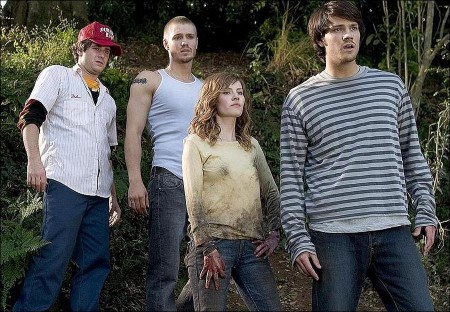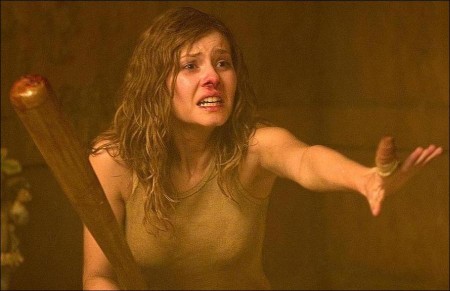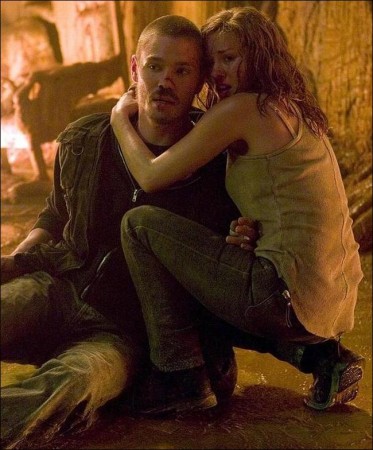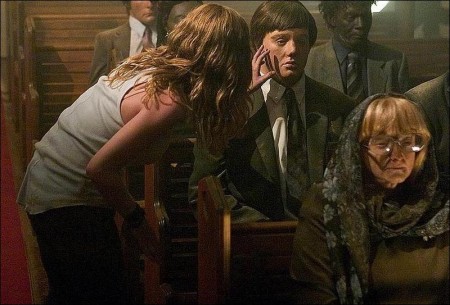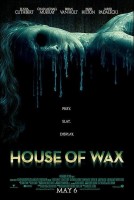Tagline: Prey. Slay. Display.
House of Wax tells the story of a group of friends who fall prey to a sinister plot while passing through a small town on their way to a college football game.
A group of friends on their way to a college football game falls prey to a pair of murderous brothers in an abandoned small town. They discover that the brothers have expanded upon the area’s main attraction – the House of Wax – and created an entire town filled with the wax-coated corpses of unlucky visitors. Now the group must find a way out before they too become permanent exhibits in the House of Wax.
What begins as a weekend getaway for six friends becomes a terrifying fight for their lives in House of Wax, an exciting re-imagining of the 1953 horror classic from Dark Castle Entertainment and producers Joel Silver and Robert Zemeckis. A road trip to the biggest college football championship of the year takes a turn for the worse for Carly (Elisha Cuthbert), Paige (Paris Hilton) and their friends when they decide to camp out for the night before heading to the game.
A confrontation with a mysterious trucker at the camp site leaves everyone unsettled, and Carly has her hands full trying to keep the peace between her boyfriend Wade and her hot-headed brother Nick. They wake up the next morning to find that their car has been deliberately tampered with. At the risk of being stranded, they accept a local’s invitation for a ride into Ambrose, the only town for miles. Once there, they are drawn to Ambrose’s main attraction—Trudy’s House of Wax, which is filled with remarkably life-like wax sculptures. But as they soon discover, there is a shocking reason the exhibits look so real.
As the friends uncover the town’s dark secrets, they are stalked by a demented killer and find themselves in a bloody battle for survival. The group must find a way out of Ambrose—or become permanent additions to the House of Wax.
Visit Trudy’s Famous House of Wax
From Dark Castle Entertainment, producers of the hit supernatural thriller Gothika and the successful horror remakes House on Haunted Hill and Thir13en Ghosts, comes House of Wax, the harrowing story of six friends on a road trip that takes a terrifying turn when they find themselves hunted by a mysterious killer hell-bent on making them the latest additions in his gruesome collection of all-too-realistic wax figures.
“House of Wax puts a modern spin on the slasher movies of the 1970s and 80s,” says producer Joel Silver, who launched Dark Castle Entertainment with partner Robert Zemeckis in 1999 with the horror hit House on Haunted Hill. “It’s a rollercoaster ride that taps into our most primal fears of being hunted down and trapped, and then thrusts you into a nightmarish scenario where nothing around you is real and escape is not an option.”
House of Wax draws its name from the 1953 horror classic starring Vincent Price as a talented sculptor who curates a wax museum featuring eerily lifelike displays. “There’s something really fascinating about wax figures,” Silver suggests. “They’re unsettling, they’re kind of creepy, but you can’t stop looking at them.”
The story takes a chilling turn when it’s discovered that Price’s character has hidden real corpses within his precious wax creations. Beyond this basic premise, Dark Castle’s production bears little resemblance to the original film. “We loved the idea of a wax museum with real people encased in wax, so we used that as a jumping-off point and created a totally new story that takes the concept to a truly terrifying level,” says Silver.
“We really pushed the envelope in terms of working with the wax medium,” director Jaume Collet-Serra agrees. “Blood and wax make a great combination of sexy and scary, and we did things with wax that have never been done on film before, from creating an entire town filled with wax figures to engulfing our cast and the House of Wax in flames in our spectacular finale. After this movie, you will never look at wax the same way again.”
The screenplay by Chad Hayes and Carey W. Hayes, twin brothers whose numerous television credits include the sci-fi TV series Mysterious Ways, pits a group of friends en route to a college football game against monstrous twin brothers working together to trap and kill their prey in a bloody quest to make them permanent citizens of their ghoulish hometown.
“Chad and Carey created a truly original story with interesting character dynamics and unique set pieces,” says producer Susan Levin, Silver Pictures’ Executive Vice President of Production, who oversees development for Dark Castle and served as a producer on Gothika. “The horror genre traditionally favors stories about strong women in peril who kick ass. Our film puts a twist on that convention with our protagonists, a sister and brother who are at odds at the beginning of the story and have to come together to fight for their survival.”
“Horror movies are typically about external forces that change your life, and either you deal with them, or you try to escape,” Jaume observes. “If you try to escape, you usually die, but if you confront the situation, you usually survive. In this film, we have a brother and sister whose biggest problem isn’t the deadly crisis they’re facing – it’s their own relationship. They have to not only find strength in themselves; they have to confront the issues between them, learn to trust each other and work together as a team to defeat the killers.”
In the role of Carly, the ambitious college student working her way toward a career in New York, the filmmakers cast Elisha Cuthbert, an accomplished young actress known for her breakout performance on the hit Fox series 24 and her title role in the feature comedy The Girl Next Door. “Elisha is incredibly talented,” Silver says. “She’s got great strength and range, from intense drama to broad comedy, and we knew she’d be perfect for Carly, a character who is extremely focused on her goals and her future, and then suddenly finds herself for her very survival.”
“Carly is different from any other character that I’ve played,” Cuthbert says. “She doesn’t really care about clothes or style; she’s focused on her career more than anything else. Then suddenly she’s fighting for her life. Her brother Nick likes to play the tough guy; he’s been in fights before. But Carly has never been in a fight, let alone a nightmare situation like this. She’s not Lara Croft – she’s just going on adrenaline.”
Chad Michael Murray, star of the WB’s popular series One Tree Hill, plays Nick, Carly’s delinquent brother who resents what he sees as her superiority. “I think Nick is the kind of kid who had a lot of potential when he was growing up, but he was never good enough to compare to his over-achieving sister,” Murray muses. “Eventually he rebelled, started to get into fights and became this hard guy, even though it’s not who he really is. The challenge for me was to bring a vulnerability to him that exists beneath his anger and frustration.”
“Chad did a great job of bringing elements to his character that let you know that beneath the tough guy front, he really cares about his friends and his sister,” Jaume says, “and you know he’s going to step up to the plate and fight to protect her.”
Self-described “evil twin” Nick’s combative rapport with his “good twin” Carly is paralleled by their tormentors’ complex and twisted relationship, as both sets of siblings struggle with issues of identity, inferiority and trust. “Chad and Elisha created a really convincing brother-sister bond,” Levin notes. “You can feel the tension and history between the characters, and at the same time, it brings a strength and depth to their connection.”
In contrast to confrontational Nick, Carly’s boyfriend Wade is “just a normal, pretty laidback guy,” says Jared Padalecki, who starred with Murray on Gilmore Girls and was recently seen in the feature film action-adventure Flight of the Phoenix. “He’s graduating college and isn’t sure what he wants to do with his life. Wade is a big fish in Gainesville, but he’s scared to move to New York with Carly and become a small fish in a big pond. That creates tension between them, and having Nick around just makes it worse.”
Despite his nice-guy status, Wade is ultimately felled by his boundless curiosity. “Wade goes into the House of Wax when he has no business being in there,” Jaume elaborates. “He goes into the garage to get a fan belt instead of waiting for the owner to give it to him. He lingers inside the Sinclair house, snooping around.
“After weeks of shooting with Jared playing this nice, overly-curious guy, I had no idea how he was going to perform when we had to film him being attacked and waxed,” the director continues. “But he was incredible. You can see the genuine fear in his eyes when the whole room goes dark and he doesn’t know where the killer is. And then later, when the killer is preparing Wade to be waxed, Jared’s performance is amazingly real. His suffering brings another layer of realism to a truly creepy sequence.”
Fatal consequences also await Carly’s best friend Paige, played by Paris Hilton. “Paris was very excited and committed to coming in and working really hard,” Silver says.
“Paige is kind of a hometown girl,” Hilton says of her character. “She’s supportive of Carly’s goals but she doesn’t see herself leaving Gainesville. She’s content there. My experience with The Simple Life helped me to find my character a little bit. During the show we went to Louisiana, and I talked to a lot of people there who couldn’t imagine living in a big city.”
“Paris did her homework,” Jaume attests. “She came in eager to learn and worked very hard on creating her character, finding the right voice for Paige and figuring out how she fits into the group.”
As for her first major acting role, Hilton reports, “It was a challenge to show real fear, to go to a place where I was really scared. And doing my death scene was definitely hard. I had the bruises to prove it! But I think I have the coolest death scene in the movie. It looks awesome.”
Robert Ri’chard plays Paige’s boyfriend Blake, who finds the fateful shortcut on his GPS that sends their caravan careening into a deadly trap. “Blake is the host of the weekend,” says Ri’chard, who was recently seen starring opposite Samuel L. Jackson in the basketball-driven drama Coach Carter. “He’s the nucleus of this group and he wants to be sure that everyone is having a good time. They wouldn’t all hang out together if it wasn’t for him. Blake is the one who invites Nick and his buddy Dalton on the trip, which sets a different tone for the weekend than the others expected.”
“Like Wade, Blake refuses to confront his problems, which leaves them both vulnerable,” Jaume says. “Wade doesn’t want to take the risk of going to New York with Carly. Blake doesn’t want to deal with the fact that his girlfriend might be pregnant. Their decisions to ‘escape’ from reality rather than deal with it have deadly consequences.”
Rounding out the group is Dalton, a sanitation worker who harbors a longtime crush on Carly, which he tries to disguise by hiding behind his ever-present video camera. “Dalton is a shy guy and he’s from more of a working class background than the other kids,” notes Abrahams, an industry veteran whose credits include roles in the hit films Meet the Parents and Scary Movie, “so he uses his video camera as his way into the group. It helps break down that social barrier for him.”
As Jaume sees it, “Dalton provides a bit of comic relief in the story, and Jon brought great energy to the character and the cast every day. He improvised and came up with lines that weren’t in the script that helped to make the group dynamic feel authentic. Even when I wasn’t around and we weren’t officially ‘working,’ he would hang out with the other actors and shoot his video camera, trying to create real moments for the film.”
Luring the unsuspecting friends into their deadly trap are brothers Bo and Vincent Sinclair. Brian Van Holt, who delivered memorable performances in such films as Black Hawk Down and S.W.A.T., plays dual roles as Bo, the owner of the town’s lone gas station, and his more artistic but equally sadistic twin Vincent. “It took a lot of effort to tap into the dark side and really commit to these characters,” admits Van Holt, who drew on the close connection between his own twin sisters in building the foundation for the brothers’ relationship. “It definitely took a toll on me. But to have an opportunity as an actor to push it to that level was a lot of fun.”
“Not only did Brian do a great job of playing these two intense characters,” Jaume points out, “but having to dress as Vincent, wearing a mask where he could only see from one eye, and maneuver around a floor made of soft wax is not easy. He pulled it off to a very frightening effect.”
In Jaume, Silver and Levin found an acclaimed commercial director whose visual acuity and deft storytelling skills made him the perfect choice to guide this hot young ensemble cast through their horrifying journey and push them to the outer limits of terror.
“I screen commercial director reels all the time,” Levin relates, “but when I watched Jaume’s reel, it really stood out to me. There is a dark edginess to it, and even though each of his commercials is unique, they share an overall vision and style. I showed his reel to Joel, and he wanted to meet him immediately.”
“What impressed me about Jaume even more than his incredible visual sense was his insightful take on the script and story, especially with respect to the characters,” says Silver of his initial meeting with the director. “It was very important to him that the character dynamics be authentic and integral to the story, and he had smart ideas and a strong vision of how the story should be told.”
“I didn’t want this film to have a slick look,” Jaume explains. “I wanted to create an unstructured, almost documentary feel for the beginning of the movie, and then as the story progresses and the characters begin to realize the horrific truth of their situation, the visuals become more controlled and stylized – but never to the point that they overshadow the characters or the story.”
Together with director of photography Steve Windon (Anacondas, Deep Blue Sea), Jaume established an ominously nuanced look for the film, in part by using natural-looking lighting and hand-held cameras. “Jaume has a totally unique style of shooting,” Silver observes. “What looks rough and raw and off the cuff is actually very strategically planned and captures the loose, energetic tone of the beginning of the film. Then he seamlessly transitions to more complex shots that amplify the audience’s fear and anticipation and deliver great scares.”
“Jaume creates shots that would give you chills even if you weren’t shooting a scary movie,” adds Jared Padalecki.
The director also took advantage of the film’s unique production schedule, which dictated that the first act of the story be shot largely in sequence. “When we shot those scenes where the audience meets the characters, the actors were discovering their characters as well,” says Jaume, who encouraged the cast to improvise. “Because of everyone’s schedules, we were not able to rehearse with the full cast until the first night of shooting. They all bonded that night.”
When I met the rest of the cast,” Paris Hilton remembers, “we all got along so well, it was like we had been friends forever.”
Elisha Cuthbert found that shooting in sequence was also helpful in building Carly’s relationship with her tormentor Bo. “It was a very physical, intense sequence to film, and at the same time, I had to react to what was happening without being able to scream or make any noise,” Cuthbert says. “It was painful stuff, but being able to shoot in sequence helped us build the intensity between the characters as their conflict escalates.”
“I was really impressed with Elisha, especially in those scenes,” says Jaume. “She was basically tied to a chair for two days straight, sweating and being beaten up. Take after take, she delivered an incredible performance full of emotion and strength and intensity, which is exhausting for an actor. But she’s very generous and gave me everything she had in every shot.”
Van Holt echoes the cast’s unanimous praise for their director’s vision, emphasis on character development and his meticulous preparation. “I loved working with Jaume,” he says. “He’s very open and communicative, and occasionally, when it was difficult to go to the place I needed to take my characters, he pushed me until I got there.”
Waxing Poetic: About the Production
Set primarily in the fictional town of Ambrose, an eerily quaint enclave tucked away in a tangle of Louisiana backroads, House of Wax was filmed at the Warner Roadshow Studios in Queensland, Australia, and on location in Guanaba, a 45 minute drive from the Studios, where director Jaume, cinematographer Steve Windon and production designer Graham “Grace” Walker (Gothika, Ghost Ship) created the film’s sprawling central set piece from scratch.
“We built a cruise liner for Ghost Ship. We built the interior of an asylum for Gothika,” Silver says. “For House of Wax, we built an entire town.”
“I read the script and I made a layout of Ambrose, and independently Grace read the script and made a layout, and they were identical,” Jaume recalls. “When it came to the style of the town, Joel wanted to do something a bit more unique than a ‘normal’ small town or the gothic look you see in typical horror films.”
“How many times do you build a town for a movie?” asks Silver, who has produced over 40 films and counts Ambrose as the first town he’s ever commissioned. “In all of our Dark Castle pictures, we like to create unique environments that you haven’t seen in the horror genre before. With Ambrose, we had the opportunity to push the envelope even further.”
Silver suggested the design team look to the small East African city of Asmara for inspiration. An exciting architectural discovery of recent years, Asmara served as a prime building ground for architectural innovation for Italian designers during the Modernist movement of the 1930s and has even earned the nickname “the Miami of Africa.”
Executive producer Herb Gains found the perfect location for Ambrose in a rambling cow paddock in Guanaba. “It was a vast open field surrounded by hills that gave it a palpable sense of isolation,” Gains says.
“We had to chase the cows away,” says Walker, whose carpenters and construction team transformed the three-acre stretch of farmland into the town of Ambrose in just ten weeks. Before building the structures, the crew dug trenches and installed water and electricity, laying two and a half miles of cable underground so that Windon and his lighting team could individually control dimmers for the 750 lamps strategically positioned along the town streets.
Along a dusty main street lined with cracked sidewalks sprouting real weeds, Walker’s crew built a gas station, a movie theater, a barber shop, a corner store, a pet shop and a few old homes. At the end of the road, a church and graveyard were constructed, and further up a hill, the old Sinclair house.
Looming over the desolate town is Ambrose’s main attraction, Trudy’s House of Wax. The film’s unlucky visitors quickly discover that the house is literally made of wax, from the streamlined-moderne exterior to the curios and furniture that lend a peculiar charm to the museum’s interior, where numerous wax figures mingle and dance in an elaborate party scene that appears to be frozen in time.
“Grace’s design for the House of Wax is drenched with foreboding detail,” Silver enthuses. “It draws you in with its stylish façade, but the closer you look, the more unsettling it becomes.”
20 tons of wax were used to create the House of Wax sets, which were constructed with traditional materials and then coated with a spray-on wax façade. “The best-colored natural wax is beeswax,” Walker informs, “which is a rich brown flecked with gold and orange. We used this beeswax hue as our under-color for the House of Wax and also for the wax that Vincent works with in the film.”
The four main sets that comprise the House of Wax – the living room, the music room, the kitchen and Vincent’s sinister basement workshop – were duplicated and modified for filming the film’s blistering climax in which the house is engulfed in flames, slowly liquefying its wax denizens.
“We basically had to hold that state between solid and liquid for ten minutes of screen time,” Jaume says. “That was the toughest part of the shoot. There’s no book on how to make wax look like it’s melting without putting heat on it, which would have melted the actors too.”
Walker’s team experimented with different types of wax to find just the right texture to build “soft sets,” which reacted physically to the actors’ touch. After each take, surfaces and furniture were painstakingly hand-painted and reset to restore them to shooting conditions.
“My favorite thing about being a designer is getting to work with such talented people,” Walker praises. “It’s a great feeling when you see your designs come to life and they exceed even your highest expectations.”
Another of Walker’s evocative sets is the disquietingly large roadkill pit that Carly and her friends stumble upon before finding their way to Ambrose – a grisly foreshadowing of the atrocities that lay ahead.
The art department created the pit using animal skulls and fur treated and checked by health officials to ensure safety, along with critter remnants made from bits and pieces of plaster. (No actual animal carcasses were used in staging this sequence.) The concoction was doused with fake blood and allowed to congeal, resulting in a putrid marinade that smelled as revolting in real life as it appears to onscreen.
“It was really gross,” Walker says with a laugh. “We had fake blood spraying everywhere and the whole thing stunk. I don’t think anyone understood how bad it was going to be!”
“When I read the script, I thought, How are they going to pull this off?” Chad Michael Murray remarks. “And they did it. They made an entire town that’s desolate and creepy and real, not to mention all the other great sets, and that made our jobs so much easier.”
“Coming from my commercial background, I’m used to being in charge of the art direction and the photography as well as the direction,” Jaume explains. “Taking on the responsibility of directing a feature film meant I had to let go and trust Grace, and that’s one of the best things I did.”
Dying Young: The 411 on the Wax Figures
Key to creating the ambience of the chillingly picturesque town of Ambrose was populating the expansive set with a host of wax “citizens.” Wax body supervisor Jason Baird, a prosthetics and special effects makeup artist whose credits include The Matrix Reloaded, The Matrix Revolutions and Star Wars: Episode II, led a team of 35 artists dedicated solely to the design and creation of the film’s wax figures.
Working twelve hour days for seven months, Baird’s team of sculptors, mold makers, painters and hair technicians created over 100 intricately detailed wax figures for the film, including the party guests at Trudy’s House of Wax; the parishioners, organist and priest gathered for a funeral at the church; and an audience and ushers in permanent attendance at the local movie theater, where the 1962 thriller What Ever Happened to Baby Jane? plays on a continuous loop. (A clever nod to the themes of intense sibling rivalry that underscore House of Wax.)
The figures that represent Bo and Vincent’s human victims who have been slayed, waxed and displayed throughout the town came to be known by the crew as “dead wax people.” These figures were made from fiberglass and translucent silicon molds. A handful of effects figures were also created for scenes requiring their breaking or burning. Following extensive anatomical research, Baird’s crew fashioned molds of bones from fake skeletons and placed them beneath the silicon skin to achieve a realistic representation of decaying bodies sheathed inside wax forms.
Four “purely wax” figures were created for the film to represent the artistry of Ambrose’s resident wax virtuoso, Trudy Sinclair, who would have crafted these lifelike sculptures in the traditional (i.e. non-deadly) manner for display in the House of Wax. Trudy’s eternal houseguests are two women dressed in flapper-era garments and headdresses, one sitting in a black beaded gown and the other in a shimmering taupe dress; a seated gentleman smoking a cigar; and a maid cleaning the kitchen. These figures required vigilant care, as they were extremely sensitive to changes in temperature, and were prone to sagging and cracking.
All of the figures used in the film are reproductions of actual living people. Baird conducted casting sessions with director Jaume Collet-Serra to pose and select extras with the right look for each figure. Casts were then taken of their heads, hands and bodies, from which fiberglass molds and silicon casts were made. The models representing the “dead wax people” sitting in the church and the packed house of the movie theater were posed and cast while seated in the actual pews and theater seats from those sets, to ensure an exact fit when the final figures were positioned for filming.
After the rough figures were sculpted to smooth perfection, painters and hair technicians meticulously applied the finishing touches, including makeup, wigs and facial hair. From body casting to clothing the finished “person,” the process took approximately three or four weeks to complete each individual figure.
“It was a huge job,” Baird says. “I’m so proud of the quality of the work we did in such a short amount of time. It’s tough to pick a favorite wax character, but one of mine is the little old lady in the church wearing a hat and carrying a rosary. She just looks so real!” (She also loses an arm to Carly in a pivotal scene.)
“I was very impressed with the terrific work that Jason and his team did,” Joel Silver says. “Every time they would show me new figures, I asked them to make me even more.”
To create additional “dead wax people” for crowd scenes in the church and movie theater, Baird outfitted background actors with silicon masks complete with fake eyes, wigs and color-matched hand coverings, and then seated them among the wax figures. Baird’s staff also sculpted figures of the main characters whose grisly deaths are followed by an even more disturbing fate: being encased in wax. Carly’s boyfriend Wade has the misfortune of falling prey to Vincent’s gory ritual.
“Through Wade’s death we show the audience Vincent’s process of capturing his victim and covering him in wax while he’s still alive,” says Jaume, who wanted to depict the deranged killer’s detailed waxing methods, as well as his body waxing contraption – which is reminiscent of a medieval torture device – in realistic detail. “I wanted to find out how you would actually wax somebody. It turned out the most efficient way would be to spray wax all over them. Designing the spraying contraption with Grace Walker was one of the toughest things in the film to achieve. I wanted a machine that would seem scary yet realistic and homemade.”
Jared Padalecki underwent a 3-D body scan prior to filming as part of being fit for his dead wax figure. The information was scanned into a computer and given to the KNB FX team in Los Angeles, who carved Padalecki’s exact body shape out of foam and used it to make a series of molds. As for the actor’s “dead wax costume,” worn in scenes showing that Wade is still alive inside his wax body casing, Padalecki was fitted with a silicon mask and hands like those worn by the actors who played dead wax people.
These production notes provided by Warner Bros. Pictures.
House of Wax
Starring: Elisha Cuthbert, Chad Michael Murray, Paris Hilton, Jared Padalecki, Jon Abrahams
Directed by: Jaume Collet-Serra
Screenplay by: Chad Hayes, Carey Hayes
Release Date: May 6th, 2005
MPAA Rating: R for horror violence, some sexual content and language.
Studio: Warner Bros. Pictures
Box Office Totals
Domestic: $32,064,800 (46.6%)
Foreign: $36,701,321 (53.4&)
Total: $68,766,121 (Worldwide)
